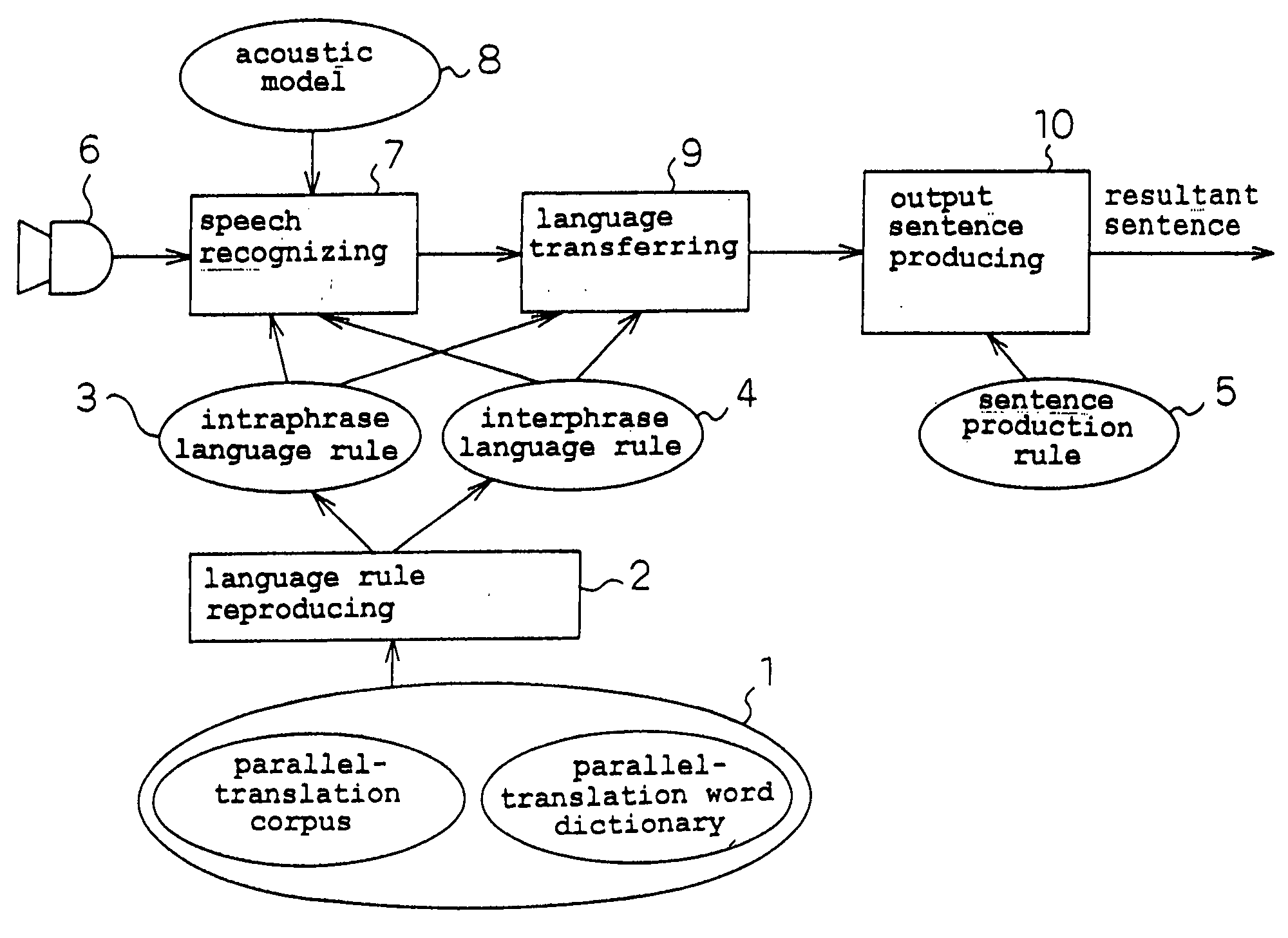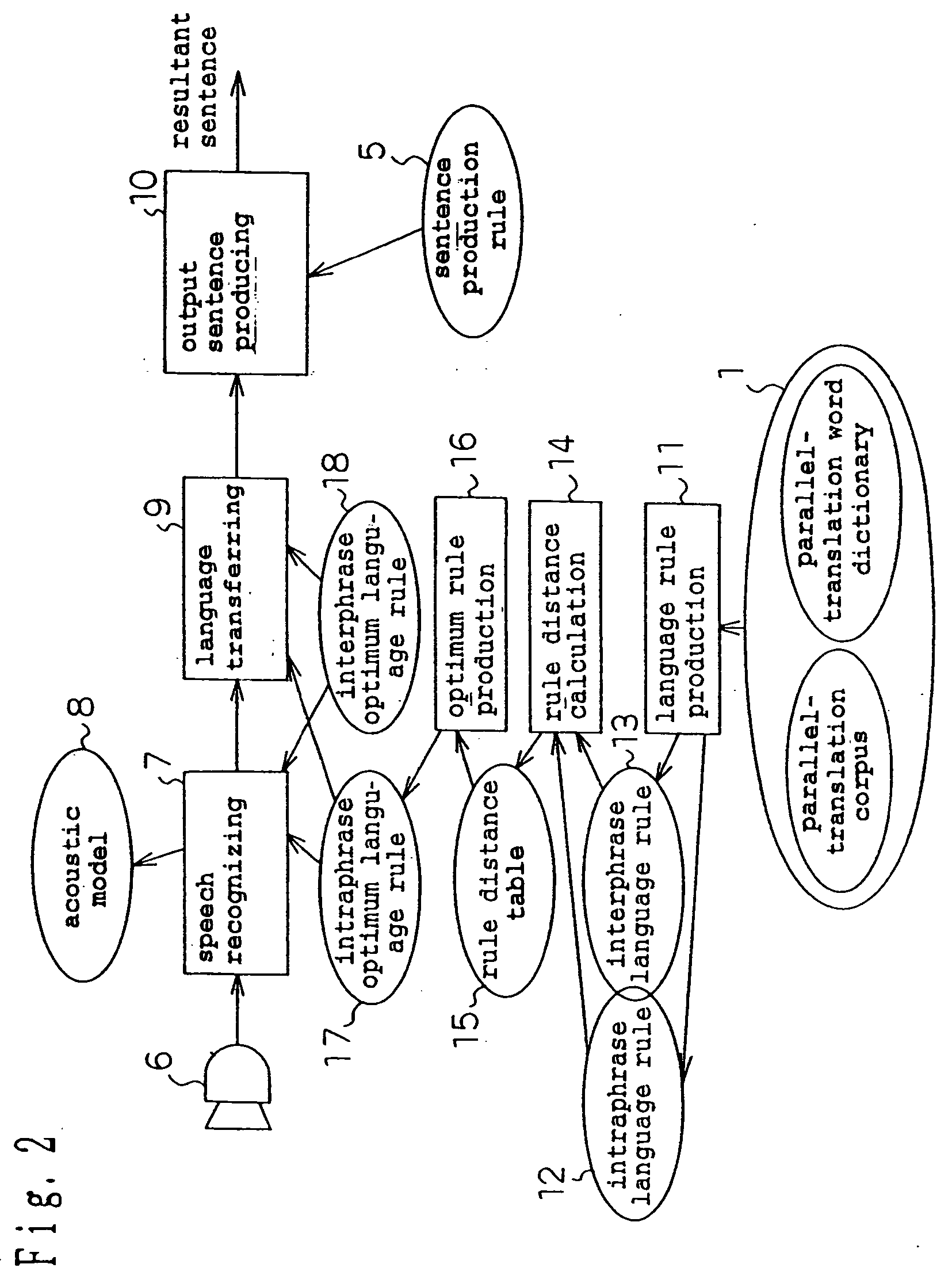Language transference rule producing apparatus, language transferring apparatus method, and program recording medium
a technology of language transference and producing apparatus, applied in the field of language transference rule producing apparatus, language transference rule method, and program recording medium, can solve the problems of difficult automatic determination of phrases for each sentence, inability to accept phrases, and inability to output translations
- Summary
- Abstract
- Description
- Claims
- Application Information
AI Technical Summary
Benefits of technology
Problems solved by technology
Method used
Image
Examples
first embodiment
[0081] First, a first embodiment will be described.
[0082] In the first embodiment, description will be made by using, as an example of a language transferring apparatus, an interpreting apparatus which performs transference between different languages, in the same manner as the conventional art examples. FIG. 1 is a block diagram of the interpreting apparatus of the embodiment.
[0083] In the interpreting apparatus of the embodiment, before interpretation is performed, a language analyzing section 2 previously trains language rules of the source language sentence and the target language sentence of an uttered sentence, from a training database 1 which has a parallel-translation corpus, a parallel-translation word dictionary, and the like. FIG. 3 shows an example of training of the language rules.
[0084] In the language rule producing section 2, content words of the source language and the target language are replaced with speech part names by using, for example, a parallel-translati...
second embodiment
[0094] Next, a second embodiment will be described with reference to the drawings. In the embodiment also, in the same manner as the first embodiment, description will be made by using an interpreting apparatus. FIG. 2 is a block diagram of the interpreting apparatus of the embodiment.
[0095] In the interpreting apparatus of the embodiment, before interpretation is performed, a language rule producing section 11 previously trains intraphrase language rules 12 and interphrase language rules 13 of the source language sentence and the target language sentence of an uttered sentence, from a training database 1 which has a parallel-translation corpus and a parallel-translation word dictionary. The trained rules are identical with the training of the language rules in the first embodiment. Next, the trained language rules are optimized. FIG. 4 shows an example of the optimization.
[0096] Among the trained style-independent phrases, phrases of the same target language are bundled as the sa...
embodiment 3
[0105] In the embodiment, description will be made by, as an example of a language transferring apparatus, using an interpreting apparatus which performs transference between different languages, in the same manner as the conventional art examples. FIG. 5 is a block diagram of the interpreting apparatus of the embodiment.
[0106] In the embodiment, a parallel-translation corpus 101, a content word definition table 103, a parallel-translation word dictionary 107, a morphological analyzing section 102, a word clastering section using part-of-speech 104, a phrase extracting section 105, a phrase determining section 106, a parallel-translation interphrase rule table 108, and a parallel-translation phrase dictionary 109 constitute an example of the language transference rule producing apparatus of the invention. The parallel-translation phrase dictionary 109 of the embodiment is an example of the phrase dictionary set forth in claim 6 of the invention.
[0107] In the interpreting apparatus...
PUM
 Login to View More
Login to View More Abstract
Description
Claims
Application Information
 Login to View More
Login to View More - R&D
- Intellectual Property
- Life Sciences
- Materials
- Tech Scout
- Unparalleled Data Quality
- Higher Quality Content
- 60% Fewer Hallucinations
Browse by: Latest US Patents, China's latest patents, Technical Efficacy Thesaurus, Application Domain, Technology Topic, Popular Technical Reports.
© 2025 PatSnap. All rights reserved.Legal|Privacy policy|Modern Slavery Act Transparency Statement|Sitemap|About US| Contact US: help@patsnap.com



